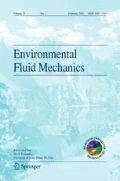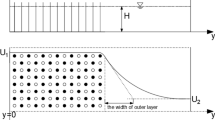Abstract
Vegetation acts as a natural protection measure as it reduces inundation depth downstream of it and dissipates the energy of flow like flood and tsunami. The present study performed a series of laboratory experiments in which the flow variations and energy dissipation around discontinuous and vertically double layered vegetation (VDLV) were investigated with changing the vegetation density and water depth under steady subcritical flow conditions. A case of vertically single layered vegetation (SLV) was also considered for comparison purpose. The results showed that incorporating an intermediate (G/d = 0.563, where G is the clear spacing between cylinders in transverse direction, and d is the diameter of cylinder) as well as dense (G/d = 0.041) short submerged vegetation within a sparse (G/d = 2.125) emergent vegetation considerably increased the backwater rise by 22–55% and 26–59%, respectively for the upstream located vegetation model (UM), whereas it raised the backwater rise by 28–53% and 35–63%, respectively for the downstream located vegetation model (DM), as compared to that of sparse SLV forest. The combination of upstream located dense VDLV and downstream located intermediate VDLV offered larger resistance to the flow and gave maximum overall loss of flow energy i.e. 43–61%. It is observed that increasing the density of short vegetation layer in UM increases resistance to the flow by narrowing the passage of fluid flow, due to which the backwater rise upstream of the UM increased and inundation depth downstream of the DM reduced significantly; and hence, consequently resulted in a significant amount of loss in the flow energy.








Similar content being viewed by others
References
Tanaka N, Yasuda S, Iimura K, Yagisawa J (2014) Combined effects of coastal forest and sea embankment on reducing the washout region of houses in the Great East Japan tsunami. J Hydro Environ 8(3):270–280
Shuto N (1987) The effectiveness and limit of tsunami control forests. Coast Eng Jpn 30(1):143–153
Tanaka N (2009) Vegetation bioshields for tsunami mitigation: review of the effectiveness, limitations, construction, and sustainable management. Lands Ecol Eng 5:71–79
Yanagisawa H, Koshimura S, Miyagi T, Imamura F (2010) Tsunami damage reduction performance of a mangrove forest in Banda Aceh, Indonesia inferred from field data and a numerical model. J Geophys Res 115:C06032
Pasha GA, Tanaka N (2017) Undular hydraulic jump formation and energy loss in a flow through emergent vegetation of varying thickness and density. Ocean Eng 141:308–325
Tanaka N, Yagisawa J, Yasuda S (2013) Breaking pattern and critical breaking condition of Japanese pine trees on coastal sand dunes in huge tsunami caused by Great East Japan Earthquake. Nat Hazards 65:423–442
Tanaka N, Sasaki Y, Mowjood MIM, Jinadasa KBSN, Homchuen S (2007) Coastal vegetation structures and their functions in tsunami protection: experience of the recent Indian Ocean tsunami. Lands Ecol Eng 3:33–45
Anjum N, Ghani U, Pasha GA, Latif A, Sultan T, Ali S (2018) To investigate the flow structure of discontinuous vegetation patches of two vertically different layers in an open channel. Water 10:75
Ghani U, Anjum N, Pasha GA, Ahmad M (2019) Numerical investigation of the flow characteristics through discontinuous and layered vegetation patches of finite width in an open channel. Environ Fluid Mech. https://doi.org/10.1007/s10652-019-09669-x
Anjum N, Tanaka N (2019) Study on the flow structure around discontinued vertically layered vegetation in an open channel. J Hydrodyn. https://doi.org/10.1007/s42241-019-0040-2
Singh P, Rahimi HR, Tang X (2019) Parameterization of the modeling variables in velocity analytical solutions of open-channel flows with double-layered vegetation. Environ Fluid Mech. https://doi.org/10.1007/s10652-018-09656-8
Rashedunnabi AHM, Tanaka N (2018) Physical modelling of tsunami energy reduction through vertically two layered rigid vegetation. In: Proceedings of the 12th ISE 2018, pp 1–10, Tokyo, Japan
Igarashi Y, Tanaka N (2018) Effectiveness of a compound defense system of sea embankment and coastal forest against a tsunami. Ocean Eng 151:246–256
Tanaka N, Sasaki Y, Mowjood MIM (2006) Effects of sand dune and vegetation in the coastal area of Sri Lanka at the Indian Ocean tsunami. Adv Geosci Hydrol Sci 6:149–159
Fadly U, Murakami K (2013) Study on reducing tsunami inundation energy by the modification of topography based on local wisdom. J Jpn Soc Civ Eng 68(I):66–71
Tsujimoto G, Kakinoki T, Mineura R, Uno K, Yamada F (2015) Scouring mechanism behind seawall from tsunami overflow and optimum conditions to reduce tsunami energy with an artificial trench. Coast Eng Proc 1:38
Rashedunnabi AHM, Tanaka N (2019) Energy reduction of a tsunami current through a hybrid defense system comprising a sea embankment followed by a coastal forest. Geosciences 9:247. https://doi.org/10.3390/geosciences9060247
Tanaka N, Yagisawa J, Sasaki Y (2012) Characteristic of damage due to tsunami propagation in river channels and overflow of their embankments in Great East Japan Earthquake. Int J River Basin Manag 10(3):269–279
Spiske M, Weiss R, Bahlburg H, Roskosch J, Amijaya H (2010) The TsuSedMod inversion model applied to the deposits of the 2004 Sumatra and 2006 Java tsunami and implications for estimating flow parameters of palaeo-tsunami. Sediment Geol 224:29–37
Nandasena NAK, Tanaka N, Sasaki Y, Osada M (2013) Boulder transport by the 2011 Great East Japan tsunami: comprehensive field observations and whither model predictions? Mar Geol 346:292–309
Ali HM, El-Gendy MM, Mirdan AMH, Ali AAM, Abdelhaleem FSF (2014) Minimizing downstream scour due to submerged hydraulic jump using corrugated aprons. Ain Shams Eng J 5:1059–1069
Igarashi Y, Tanaka N (2016) Multiple defense for tsunami inundation by two embankment system and prevention of oscillation by trees on embankment. In: Proceedings of the 20th congress of IAHR APD Congress, Colombo, Sri Lanka, pp 28–31
Tanaka N (2012) Effectiveness and limitations of coastal forest in large tsunami: conditions of Japanese pine trees on coastal sand dunes in tsunami caused by Great East Japan Earthquake. J Jpn Soc Civ Eng 68(4):7–15
Igarashi Y, Tanaka N, Sato H, Torita H (2019) Tsunami mitigation effect and tree breaking situation of Dahurian larch coastal forest at six growth stages under thinning management of trees. In: Proceedings of the 38th IAHR world congress, Panama City, Panama
Takemura T, Tanaka N (2007) Flow structures and drag characteristics of a colony-type emergent roughness model mounted on a flat plate in uniform flow. Fluid Dyn Res 39:694–710
Iimura K, Tanaka N (2012) Numerical simulation estimating effects of tree density distribution in coastal forest on tsunami mitigation. Ocean Eng 54:223–232
Japan Society of Fluid Mechanics (1998) Handbook of fluid mechanics, 2nd edn. Japan Society of Fluid Mechanics, Maruzen, Tokyo, pp 237–240 (in Japanese)
Tanaka N, Yagisawa J (2010) Flow structures and sedimentation characteristics around clump-type vegetation. J Hydro Environ Res 4:15–25
Aniel-Quiroga Í, Vidal C, Lara JL, González M, Sainz Á (2018) Stability of rubble-mound breakwaters under tsunami first impact and overflow based on laboratory experiments. Coast Eng 135:39–54
Chow VT (1959) Open channel hydraulics. McGraw-Hill Publishing Co., New York
Cain P (1978) Measurements within self-aerated flow on a large spillway. Ph.D. thesis, Ref. 78–18, Department of Civil Engineering, University of Canterbury, Christchurch, New Zealand
Chanson H (2004) Air–water flows in water engineering and hydraulic structures. Basic processes and metrology. In: Yazdandoost F, Attari J (eds) Hydraulics of dams and river structures. Taylor & Francis Group, London
Baldy S (1993) A generation-dispersion model of ambient and transient bubbles in the close vicinity of breaking waves. J Geophys Res 98(C10):18277–18293
Ma G (2012) Multiscale numerical study of turbulent flow and bubble entrainment in the surf zone. Ph.D. thesis, University of Delaware, Newark
Na B, Chang KA, Huang ZC, Lim HJ (2016) Turbulent flow field and air entrainment in laboratory plunging breaking waves. J Geophys Res Oceans 121:2980–3009
Chanson H (1993) Characteristics of undular hydraulic jumps (No. CE146). Department of Civil Engineering, The University of Queensland
Righetti M, Armanini A (2002) Flow resistance in open channel flows with sparsely distributed bushes. J Hydrol 269:55–64
Tang X, Rahimi H, Singh P, Wei Z, Wang Y, Zhao Y, Lu Q (2019) Experimental study of open-channel flow with partial double-layered vegetation. E3S Web Conf 81:01010. https://doi.org/10.1051/e3sconf/20198101010
Poggi D, Porporato A, Ridolfi L, Albertson JD, Katul GG (2004) The effect of vegetation density on canopy sub-layer turbulence. Bound Lay Meteorol 111(3):565–587
Zhao F, Huai W (2016) Hydrodynamics of discontinuous rigid submerged vegetation patches in open-channel flow. J Hydro Environ Res 12:148–160
Ghisalberti M, Nepf H (2006) The structure of the shear layer in flows over rigid and flexible canopies. Environ Fluid Mech 6(3):277–301
Raupach MR, Finnigan JJ, Brunei Y (1996) Coherent eddies and turbulence in vegetation canopies: the mixing-layer analogy. Bound Layer Meteorol 78:351
Ricardo AM, Koll K, Franca MJ, Schleiss AJ, Ferreira RML (2014) The terms of turbulent kinetic energy budget within random arrays of emergent cylinders. Water Resour Res 50:4131–4148. https://doi.org/10.1002/2013WR014596
Anjum N, Tanaka N (2019) Numerical modeling of the turbulent flow structure through vertically double layer vegetation. J Jp Soc Civil Eng, Ser. B1(Hydraulic Engineering) 75(2):I_487–I_492
Pasha GA, Tanaka N (2016) Effectiveness of finite length inland forest in trapping tsunami-borne wood debris. J Earthq Tsunami 2:1650008. https://doi.org/10.1142/S1793431116500081
Irish JL, Weiss R, Yang Y, Song YK, Zainali A, Marivela-Colmenarejo R (2014) Laboratory experiments of tsunami runup and withdrawal in patchy coastal forest on a steep beach. Nat Hazards 74:1933. https://doi.org/10.1007/s11069-014-1286-1
Yang Y, Irish J, Weiss R (2017) Impact of patchy vegetation on tsunami dynamics. J Waterw Port Coast Ocean Eng 143:04017005. https://doi.org/10.1061/(asce)ww.1943-5460.0000380
Tanaka N, Jinadasa KBSN, Mowjood MIM, Fasly MSM (2011) Coastal vegetation planting projects for tsunami disaster mitigation-effectiveness evaluation of new establishments. Lands Ecol Eng 7:127–135
Anjum N, Tanaka N (2019) Physical modeling of tsunami flow through discontinuous vegetation. In: Proceedings of the 21st international summer symposium, Japan Society of Civil Engineers (JSCE), CS2-34
Pasha GA, Tanaka N (2019) Critical resistance affecting sub to super-critical transition flow by vegetation. J Earthq Tsunami. https://doi.org/10.1142/S1793431119500040
Yagci O, Yildirim I, Celik MF, Kitsikoudis V, Duran Z, Kirca VSO (2017) Clear water scour around a finite array of cylinders. Appl Ocean Res 68:114–129
Author information
Authors and Affiliations
Corresponding author
Additional information
Publisher's Note
Springer Nature remains neutral with regard to jurisdictional claims in published maps and institutional affiliations.
Rights and permissions
About this article
Cite this article
Anjum, N., Tanaka, N. Experimental study on flow analysis and energy loss around discontinued vertically layered vegetation. Environ Fluid Mech 20, 791–817 (2020). https://doi.org/10.1007/s10652-019-09723-8
Received:
Accepted:
Published:
Issue Date:
DOI: https://doi.org/10.1007/s10652-019-09723-8




